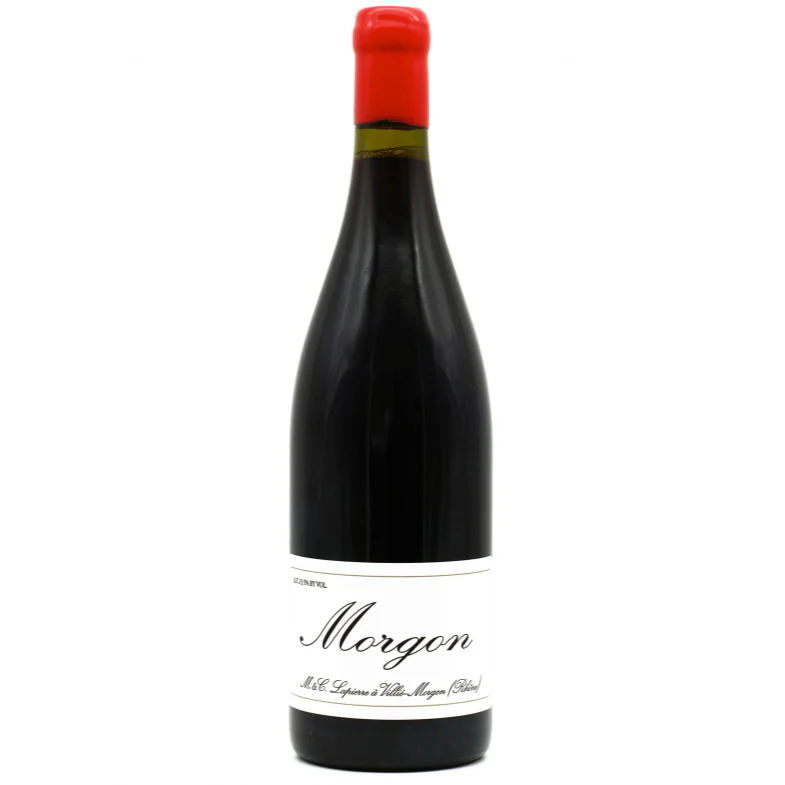
LAPIERRE MORGON 2023
LAPIERRE MORGON 2023
LAPIERRE MORGON 2023 92VM
Morgon, Beaujolais, France
92 pts Vinous
This bottle of 2023 Morgon comes from the first bottling run completed in March 2024 (there will be five bottlings until September). Lapierre told me that this is destined for markets in Japan, Canada and a little for the US. The nose reveals dark berry fruit, sous-bois and light Indian ink aromas. The palate is medium-bodied with pliant tannins and crisp acidity, a little rustic in a good way with a slightly savory finish. Lovely.
- By Neal Martin on March 2024
Mathieu Lapierre, unofficially the coolest dude in Beaujolais, was sporting shades and a t-shirt that made him look as if he had just returned from an all-night rave somewhere around the M25 in 1989. He’s also one of the most erudite winemakers to speak to about all things Beaujolais and natural wines since his father, Marcel, was one of the movement's forefathers. Lapierre always expresses an open-mindedness that is lacking elsewhere. To that end, for many years, he has produced two cuvées of Morgon, with and without SO2. I always taste these blind, and on this occasion, I just sided with the non-sulfité iteration. His sister and co-owner, Camille, joined us briefly in the early spring sunshine. “The 2023 vintage was really hard,” he told me. “Camille was in the cellar, and I was in the vineyard. There was a lot of sunburn, and we suffered hail four times in Morgon, which bore the brunt. Consequently, yields were reduced from 65hL/ha to 40hL/ha. Some of the berries had a hard taste. I was worried about there being bad microorganisms, and I feared there might be Brettanomyces. Thankfully, there isn’t any.” Lapierre has a legion of admirers, some that have followed the Domaine since his father’s era. These are wonderful expressions of Morgon, transparent and characterful; you can choose how “natural” you want it. Readers should note that there are five bottlings planned for this year, and I specified which markets this first bottling is destined for in my tasting notes.
The wine that helped Cru Beaujolais catch fire and get everyone's attention, the 2009 was the wine and that was 12 years ago...here we are with not enough wine to meet demand, so please, send orders in ASAP as these won't last and I will allocate if need be.
In the northern hills of Beaujolais lies the pastoral Villie-Morgan, one of the ten cru villages permitted to print its name on the bottle, and also considered home of one of the best wines in Beaujolais. An hour from Lyon, the second largest city in France, Villie-Morgan is a century away in atmosphere. It is also home to a group of groundbreaking and sometimes controversial winemakers know in the US as the Gang of Four.
This group, informally spearheaded by Marcel Lapierre, strives to make wines as naturally as possible, in the vineyard and in the winery. Lapierre's vines average 40 years of age, and his grapes are always picked at the latest possible moment in order to obtain the ripest possible fruit. No pesticides or chemicals are used in the vineyards and no sulfur or yeast is added during fermentation. The resulting wines are pure and fruity, not overly alcoholic, and always a pleasure to drink
From biodynamically-farmed, decomposed granite vineyards in the Cru of Morgon, the Gamay grapes are picked with a mind for rainbow spectrum fleshy, ripe fruit (blood orange to bright red, and on through to black plum and cherry). Coupled with stony, flinty minerality, a gorgeous core of fine tannin, and fresh acidity, Domaine Marcel Lapierre's Morgon makes us happier than we can convey.
Little would we know that when Marcel Lapierre took over the family Domaine from his father in 1973, he was on the road to becoming a legend. In 1981, his path would be forever changed by Jules Chauvet, a man whom many now call his spiritual godfather. Chauvet was a winemaker, a researcher, a chemist, and a viticultural prophet. It was he who, upon the advent of chemical fertilizers and pesticides in the 1950s, first spoke out for "natural wine," harkening back to the traditional methods of the Beaujolais. Joined by local vignerons Guy Breton, Jean-Paul Thévenet, and Jean Foillard, Marcel spearheaded a group that soon took up the torch of this movement. Kermit dubbed this clan the Gang of Four, and the name has stuck ever since. These rebels called for a return to the old practices of viticulture and vinification: starting with old vines, never using synthetic herbicides or pesticides, harvesting late, rigorously sorting to remove all but the healthiest grapes, adding minimal doses of sulfur dioxide or none at all, and disdaining chaptalization. Sadly, the end of the 2010 vintage was Marcel's last. He passed away at the end of the harvest--a poetic farewell for a man that forever changed our perception of Beaujolais. His son Mathieu and daughter Camille confidently continue the great work that their father pioneered, now introducing biodynamic vineyard practices and ensuring that Marcel's legacy lives on.
Usually ready in 2-4 days
Pickup available, usually ready in 2-4 days
200 Trans Air Drive
Suite 200
Morrisville NC 27560
United States
+19198671879





